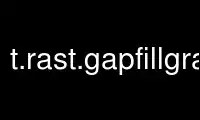
This is the command t.rast.gapfillgrass that can be run in the OnWorks free hosting provider using one of our multiple free online workstations such as Ubuntu Online, Fedora Online, Windows online emulator or MAC OS online emulator
PROGRAM:
NAME
t.rast.gapfill - Replaces gaps in a space time raster dataset with interpolated raster
maps.
KEYWORDS
temporal, interpolation, raster, time
SYNOPSIS
t.rast.gapfill
t.rast.gapfill --help
t.rast.gapfill [-t] input=name [where=sql_query] basename=string [nprocs=integer]
[--help] [--verbose] [--quiet] [--ui]
Flags:
-t
Assign the space time raster dataset start and end time to the output map
--help
Print usage summary
--verbose
Verbose module output
--quiet
Quiet module output
--ui
Force launching GUI dialog
Parameters:
input=name [required]
Name of the input space time raster dataset
where=sql_query
WHERE conditions of SQL statement without ’where’ keyword used in the temporal GIS
framework
Example: start_time > ’2001-01-01 12:30:00’
basename=string [required]
Basename of the new generated output maps
A numerical suffix separated by an underscore will be attached to create a unique
identifier
nprocs=integer
Number of interpolation processes to run in parallel
Default: 1
DESCRIPTION
t.rast.gapfill fills temporal gaps in space time raster datasets using linear
interpolation. Temporal all gaps will be detected in the input space time raster dataset
automatically. The predecessor and successor maps of the gaps will be identified and used
to linear interpolate the raster map between them.
NOTES
This module uses r.series.interp to perform the interpolation for each gap independently.
Hence several interpolation processes can be run in parallel.
Examples
In this example we will create 3 raster maps and register them in the temporal database an
then in the newly created space time raster dataset. There are gaps of one day size
between the raster maps. The values of the maps are chosen so that the interpolated values
can be estimated. We expect two maps with values 2 and 4 after interpolation.
r.mapcalc expression="map1 = 1"
r.mapcalc expression="map2 = 3"
r.mapcalc expression="map3 = 5"
t.register type=raster maps=map1 start=2012-08-20 end=2012-08-21
t.register type=raster maps=map2 start=2012-08-22 end=2012-08-23
t.register type=raster maps=map3 start=2012-08-24 end=2012-08-25
t.create type=strds temporaltype=absolute \
output=precipitation_daily \
title="Daily precipitation" \
description="Test dataset with daily precipitation"
t.register type=raster input=precipitation_daily maps=map1,map2,map3
t.rast.list input=precipitation_daily columns=name,start_time,min,max
name|start_time|min|max
map1|2012-08-20 00:00:00|1.0|1.0
map2|2012-08-22 00:00:00|3.0|3.0
map3|2012-08-24 00:00:00|5.0|5.0
t.rast.list input=precipitation_daily method=deltagaps
id|name|mapset|start_time|end_time|interval_length|distance_from_begin
map1@PERMANENT|map1|PERMANENT|2012-08-20 00:00:00|2012-08-21 00:00:00|1.0|0.0
None|None|None|2012-08-21 00:00:00|2012-08-22 00:00:00|1.0|1.0
map2@PERMANENT|map2|PERMANENT|2012-08-22 00:00:00|2012-08-23 00:00:00|1.0|2.0
None|None|None|2012-08-23 00:00:00|2012-08-24 00:00:00|1.0|3.0
map3@PERMANENT|map3|PERMANENT|2012-08-24 00:00:00|2012-08-25 00:00:00|1.0|4.0
t.rast.gapfill input=precipitation_daily basename=gap
t.rast.list input=precipitation_daily columns=name,start_time,min,max
name|start_time|min|max
map1|2012-08-20 00:00:00|1.0|1.0
gap_6|2012-08-21 00:00:00|2.0|2.0
map2|2012-08-22 00:00:00|3.0|3.0
gap_7|2012-08-23 00:00:00|4.0|4.0
map3|2012-08-24 00:00:00|5.0|5.0
Use t.rast.gapfillgrass online using onworks.net services
